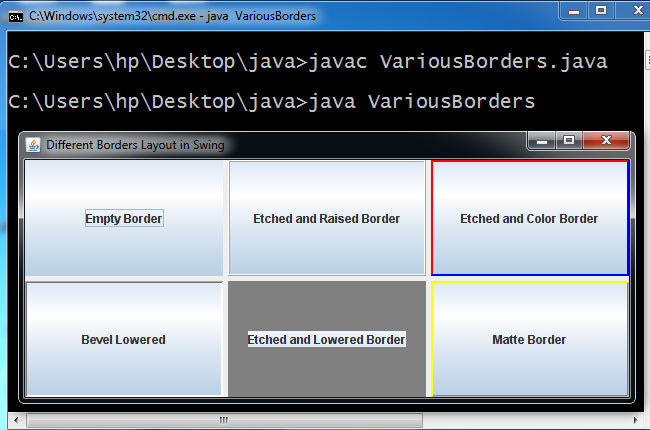
Add Border to JPanel
Borders are basically margined around the edges of a Swing component. Borders are useful for providing titles and empty spaces around components. The setBorder() is used to put a border around a component.
Borders in JPanel Example
import java.awt.*;
import javax.swing.*;
import javax.swing.border.*;
import java.awt.event.*;
public class VariousBorders extends JPanel
{
Border border;
JButton butn;
public VariousBorders()
{
setLayout(new GridLayout(2,3,5,5));
butn=new JButton(“Empty Border”);
//create a button with an empty border
border=new EmptyBorder(1,1,1,1);//top=1,left=1,bottom=1,right=1
butn.setBorder(border);
add(butn);//add button to the panel
//create a button with raised and etched border
butn=new JButton(“Etched and Raised Border”);
border=new EtchedBorder(EtchedBorder.RAISED);//set the border(raised&etched)
butn.setBorder(border);
add(butn);
//create a button with color and etched border
butn=new JButton(“Etched and Color Border”);
butn.setOpaque(true);
border=new BevelBorder(EtchedBorder.RAISED,Color.red,Color.blue);//highlight and shadow
butn.setBorder(border);
add(butn);//add button to the panel
//create a button with a bevel border raised
butn=new JButton(“Bevel Lowered”);
border=new BevelBorder(BevelBorder.LOWERED);//set the border(bevel)
butn.setBorder(border);
add(butn);
//create a button with a bevel border lowered
butn=new JButton(“Etched and Lowered Border”);
Icon icon=new ImageIcon(“aa.gif”);
//create a button with a specified inset
border=new MatteBorder(50,20,50,20,icon);//top,left,bottom,right
butn.setBorder(border);
add(butn);
//create a button with a matte border
butn=new JButton(“Matte Border”);
//highlight and shadow
border=new BevelBorder(EtchedBorder.LOWERED,Color.gray,Color.yellow);
butn.setBorder(border);
add(butn);
}
public static void main(String aa[])
{
//calls the VariousBorders constructor
VariousBorders varBrds=new VariousBorders();
JFrame frame=new JFrame(“Different Borders Layout in Swing”);//set the text on the frame
frame.setContentPane(varBrds);
//pack()is used to compress the pane with respect to the components placed
frame.pack();
//display the frame
frame.setVisible(true);
}
}

Explanation….
The package javax.swing.border contains a list of classes for practical borders.
Empty Border—used to draw the transparent margin without any associative drawing.
Etched Border—border either produces an etched-in or etched-out effect for a component.
Matte Border—The matte pattern is created by either a solid color or a titled icon.


